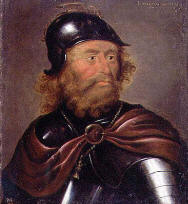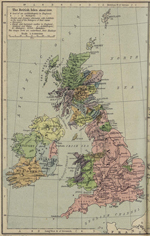|

Robert the Bruce 1274-1329
Robert the Bruce
was also called Robert I or Robert VIII de Bruce. He
was Earl of Carrick and King of Scotland.
|
|
Robert the Bruce was the king who brought Scotland independence from
English rule for 300 years.
Although he received criticism for his
original hesitation to show his allegiance, he later proved to be
fully committed to the Scottish cause.
To this day, Robert the Bruce, alongside William Wallace and
Sean Connery, are the
celebrated heroes of the Scots. |
Robert's Background
In 1290, the line of direct succession to the Scottish throne was
interrupted. Robert's grandfather claimed the title but was not able
to take the throne.
The last Scottish ruler was Margaret who died in 1290. Margaret was
a great-niece of the ruling king Edward I of England. The latter
found this sufficient grounds to declare himself sovereign of
Scotland. He enthroned John de Balliol as his puppet king.
John soon found it impossible to comply with the English terms and
finally revolted. At Dunbar, John's forces were defeated and he
abdicated in favor of Edward I. More than 20 years of civil war
followed.
Robert's Coronation and Early Years
In 1306, Robert murdered
John Comyn, the nephew of John de Balliol.
Having disposed of all other throne rivals, Robert was crowned
Scottish king.
TRIVIA:
700 years have passed
since Robert the Bruce did away with John Comyn. A moment of reflection. Read
here.
For this slaughter, however, he was outlawed by Edward I and
excommunicated by the pope. He suffered defeat at Methven and
Dalry.
His family and many of his supporters were captured and three of his
brothers executed. Robert went underground and waged guerrilla
warfare, recovering his kingdom piece by piece.
In 1307, Edward I died and was succeeded by his less competent son
Edward II. By the year 1314 all of Scotland had been cleared of
English troops, with the exception of Stirling Castle.
Battle of Bannockburn
The high point of the Scottish War of Independence and one of the
most important battles in British history was the Battle of
Bannockburn in 1314.
English troops advanced to relieve the garrison of Stirling.
Scottish troops, approximately one third the size of the enemy, were
in position, waiting.
By executing a brilliant strategy, Robert the Bruce not only won the battle
for the Scots but also freedom from English rule.
Declaration of Arbroath
In 1320, Edward II still refused to acknowledge an independent
Scotland. The Scottish nobles therefore drafted a letter to the
pope, declaring that Robert I was their rightful monarch.
This letter is known as the Declaration of Arbroath and is important
in Scottish history.
It reads,
�We gather from the deeds and books of the ancients, that
among other distinguished nations our own nation, namely of Scots,
has been marked by many distinctions.�
It further warns its king,
�Were he to desist from what he has
undertaken and be willing to subject us or our kingdom to the king
of the English or the English, we would strive to expel him
forthwith as our enemy and as a subverter of right, his own and
ours, and make someone else our king who is equal to the task of
defending us."
Treaty of Northampton
It was not until 1328 that Edward III, son of Edward II, finally
gave up all claims over the Scots by signing the Treaty of
Northampton and hereby recognizing Robert I as king of the Scots.
Death and Burial of Robert the Bruce
Robert possibly died of leprosy. His dying wish was that after his
death his chief deputy, Sir James Douglas, would carry his heart on
 crusade. James intended to fulfill this wish but unfortunately he
was killed in battle.
crusade. James intended to fulfill this wish but unfortunately he
was killed in battle.
Robert's heart is said to have been recovered and brought back to
Scotland. Therefore, Robert's body lies in Dunfermline Abbey but his
heart is buried in Melrose Abbey.
Robert the Bruce
Timeline
1274 July 11 - Birth at Turnberry Castle, Ayrshire, Scotland
1304 Robert's father dies
1306 Crowned King Robert I of Scotland
1306 Defeat at Methven and Tyndrum
1313 Capture of Perth
1314 Battle of Bannockburn
1318 Capture of Berwick
1327 Deposition of Edward II (son of Edward I)
1328 Treaty of Northampton
1329 June 7 - Death in Cardross, Dunbartonshire, Scotland
Here is
 Robert
the Bruce in the stream of time.
Robert
the Bruce in the stream of time.
And here is the map

1300
British Isles
More History
|